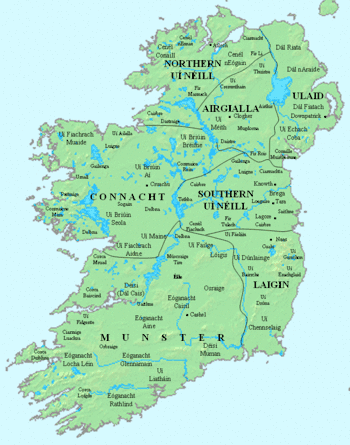Conmaicne Cuile
The Conmhaícne Cúile or Conmaicne Cuile Tolad (transl. Conmaicne of the wood of lament) were an early people of Ireland. Their tuath comprised, at minimum, most of the barony of Kilmaine, in County Mayo.
Origin
The Conmhaicne or Conmaicne were an people of early Ireland, perhaps related to the Laigin, who dispersed to various parts of Ireland. They settled in Connacht and Longford, giving their name to several Conmaicne territories. [1][2] Other branches of Conmaicne were located in County Galway, Roscommon, Mayo, and Leitrim.
Cuile means woods or forest. Ruaidhrí Ó Flaithbheartaigh linked "Cúile" with Cullagh townland ("An Choilleach", the woods). Irish: Maigh Tuireadh ("plain of a lament") is the place where the 1st battle of Moytura was fought.[3] Tuiredh translates as "a lament".[4] "Moytura" is a corruption of Irish: Maigh Tuiredh. Some Latin texts reference them as "Conmacgneculy" and "Conmacniculy".[5]
Territory

Knox said their territory comprised the baronies Ross and much of Kilmaine (except parts east, and north of the Robe).[6] East Kilmaine was occupied by the Muinter Crechain.[6] To the north was "Maigh Ceara", now the barony of Carra, County Mayo.[7]
The alternative name for the barony of Kilmaine, Coolagh, probably reflects the ancient population group named Conmaicne Cuile. Their territory was bounded by lakes, and native Irish forests in places.
Septs
The chief Conmaicne Cuile family was Ó Talcharain. The primary septs were:-
- Ó Talcharain, Ó Talcharan.[8]
- Ó Morann (Moran)
- Ó Martain (Martin or Martins)
Conmaicne Cuile Tolad was invaded by Anglo-Normans about the middle of the thirteenth century, and granted to Maurice Fitzgerald. Another deed calls the district the cantred of 'Keneloch', probably Kinlough north-east of Moyne, an chief manor of the area. In later times the Burkes controlled the territory.[9]
Patrican churches
In the original Vita tripartita Sancti Patricii, Tírechán said Saint Patrick travelled through Conmaicne Dunmore to Conmaicne Cuile Tolad and established Christian churches here.[10][11] Knox identified these new churches as Kilmaine-beg, Shrule, and perhaps the Church of Cross. Earlier Patrician churches already existed at Kilmainemore, Kilbennan, Donaghpatrick, and perhaps Templepatrick at "Inchanguill".[12]
See also
- Conmhaicne
- Conmaicne Carra
- Cath Maige Tuired
References
- MacKillop 2004.
- AFM & p417.
- Wilde 2013, p. 19.
- eDIL, "http://edil.qub.ac.uk/42381"
- Twemlow 1915.
- Knox 1908, p. 281.
- Mac Neill 1932, p. 19.
- Matheson 1894.
- Manning 1987.
- Manning 1987, pp. 3-4.
- Mac Neill 1932, p. 15.
- Knox 1908, p. 28.
Secondary sources
- Annals of the Four Masters, ed. & tr. John O'Donovan (1856). Annála Rioghachta Éireann. Annals of the Kingdom of Ireland by the Four Masters... with a Translation and Copious Notes. 7 vols (2nd ed.). Dublin: Royal Irish Academy. CELT editions. Full scans at Internet Archive: Vol. 1; Vol. 2; Vol. 3; Vol. 4; Vol. 5; Vol. 6; Indices.
- MacKillop, James (2004). "Conmaicne. Oxford Reference.". A Dictionary of Celtic Mythology. Oxford University Press.CS1 maint: ref=harv (link)
- Ó Cróinín, Dáibhí (2016). A Miracle of Learning: Studies in Manuscripts and Irish Learning: Essays in Honour of William O'Sullivan. Routledge. ISBN 978-1351963220.CS1 maint: ref=harv (link)
- Wilde, William R. (2013). Lough Corrib, Its Shores and Islands: with Notices of Lough Mask (illustrated ed.). Lulu.com. ISBN 978-1291406757.CS1 maint: ref=harv (link)
- Twemlow, J A (1915). "Calendar of Papal Registers Relating To Great Britain and Ireland".CS1 maint: ref=harv (link)
- A Chorographical Description of West or H-Iar Connaught written A.D. 1684 by Roderic O'Flaherty ESQ with notes and Illustrations by, James Hardiman M.R.I.A., Irish Archaeological Society, 1846.
- Manning, Conleth (1987). "EXCAVATION AT MOYNE GRAVEYARD, SHRULE, CO. MAYO". Proceedings of the Royal Irish Academy. Section C: Archaeology, Celtic Studies, History, Linguistics, Literature. National Parks and Monuments Branch, Office of Public Works, Dublin. 87C: 37–70. JSTOR 25506148.CS1 maint: ref=harv (link)
- Mac Neill, Eoin (1932). "The Vita Tripartita of St. Patrick". Ériu. Ériu, vol. 11: 1–41. JSTOR 30008085.CS1 maint: ref=harv (link)
- Knox, Hubert Thomas (1908). The History of the County of Mayo, to the close of the sixteenth century (PDF). Dublin: Hodges, Figgis & Co., Ltd.CS1 maint: ref=harv (link)
- Matheson, Robert E (1894). Surnames in Ireland : Registrar-General: special report in appendix to 29th Annual Report (PDF). Great Britain. Parliament. House of Commons. Select Committee.CS1 maint: ref=harv (link)